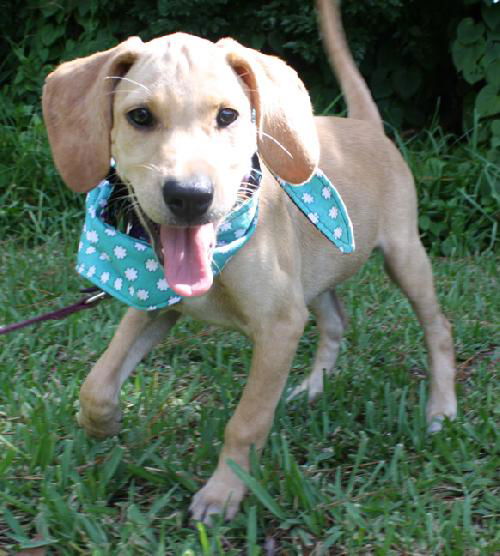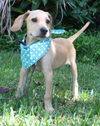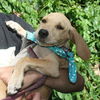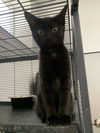Welcome to Pet Rescue By Judy!
401 South Laurel Avenue
Sanford, FL 32771
(407) 302-4497
info@petrescuebyjudy.com
Lemonade the Bloodhound Puppy's Web Page

| My Rescue |
| Login to Remember your Favorite Animals and Breeds! |
Name: Lemonade the Bloodhound Puppy
Status: Adopted!
Adoption Fee: $275
Species: Dog
Breed: Bloodhound (short coat)
Learn more about the Bloodhound.Color: Fawn
Sex: Female (spayed)
Current Size: 15 Pounds
Potential Size: 60 Pounds
General Potential Size: X-Large
Current Age: 15 Years 2 Months (best estimate)
Activity Level: Moderately Active
Indoor or Outdoor: Indoor Only
Good with Dogs: Yes
Microchipped: Yes
Lemonade the Bloodhound Puppy's brother, Vir (Apollo) the Hound (adopted) can also be seen on our website.
Lemonade the Bloodhound Puppy's brother, Sinclair the Bloodhound Puppy (adopted) can also be seen on our website.
Lemonade the Bloodhound Puppy's brother, Sheridan the Bloodhound Puppy (adopted) can also be seen on our website.
Lemonade the Bloodhound Puppy's brother, Londo the Bloodhound Puppy (adopted) can also be seen on our website.
Lemonade the Bloodhound Puppy's brother, Lennier the Bloodhound Puppy (adopted) can also be seen on our website.
Lemonade the Bloodhound Puppy's brother, Jikar the Bloodhound Puppy (adopted) can also be seen on our website.
Lemonade the Bloodhound Puppy's sister, Heather the Bloodhound Puppy (adopted) can also be seen on our website.
Lemonade the Bloodhound Puppy's brother, Sinclair the Bloodhound Puppy (adopted) can also be seen on our website.
Lemonade the Bloodhound Puppy's brother, Sheridan the Bloodhound Puppy (adopted) can also be seen on our website.
Lemonade the Bloodhound Puppy's brother, Londo the Bloodhound Puppy (adopted) can also be seen on our website.
Lemonade the Bloodhound Puppy's brother, Lennier the Bloodhound Puppy (adopted) can also be seen on our website.
Lemonade the Bloodhound Puppy's brother, Jikar the Bloodhound Puppy (adopted) can also be seen on our website.
Lemonade the Bloodhound Puppy's sister, Heather the Bloodhound Puppy (adopted) can also be seen on our website.
Description:
Lemonade and her 7 siblings somehow found themselves in a high-kill shelter where their time was up so we had to step in and rescue them.
Appearance (Coloring, texture, etc. Don't let pictures do all the work... describe the pet in detail!): Lemonade is a short-haired and resembles a yellow lab in color and hair texture.
• Activity Level (High, moderate, low, sleep patterns, etc.): She naps often after small spurts of very high activity.
• Adaptability (How quickly does he or she respond to new situations?): She seems to respond well to new experiences.
• Friendliness (Very friendly, friendly, cautious, issues with particular people, protectiveness, etc.): She was initially cautious when we first got her, but has quickly become very friendly with us and visitors.
• Personality (What sets this pet apart from other animals you've cared for? Please share their unique personality traits or mannerisms): She is very much in throes of puppy behavior.
• Feeding Habits (How much and how frequently does the pet eat? Does he or she prefer dry food or wet food?) 1 1/2 cups of dry puppy food 2 times a day
• Family Friendly (How is the pet with kids? Other dogs/cats? Visitors?) She is good with the kids. We have not seen her interact with other dogs or cats yet. She is friendly with visitors.
• House Friendly (Is the pet crate trained? Housetrained? Any chewing tendencies or other behaviors toward the home?): She is crate trained. She initially spent a lot of time in the crate, but now has ventured out more often to the couch and recliner. She is not allowed in bedrooms.
• Yard Friendly (How does the pet behave when outside? Any digging or jumping? Chasing other animals?) She is learning to walk on a leash, but needs some training. She is digging when given the chance (only in sandy areas without grass... which at the moment is a good portion of our lawn).
• Obedience (Does the pet know how to sit? Shake? Lay down? Stay? Come? Games? Tell us about their obedience!) She will sit and stay. The boys have her "snap" which is sit then jump up for a treat.
• Trainability (How quickly or easily has it been to train new behaviors or tricks? Tell us about those experiences.): she seems rather easily trainable.
• Ideal Home (What do you think would constitute an ideal home for your pet? Also, what situations should be avoided?): She would be good in most homes. She is already quite strong for her size and getting bigger and heavier... her eventual size would need to be a consideration.
According to www.dogbreedinfo.com, this breed is more than one thousand years old. It was perfected, not created, by monks of St. Hubert in Belgium. Later the dogs were brought by the Normans into England and then to the United States. It is also known as the Flemish Hound. Throughout the world, breeds such as the American Coonhounds, Swiss Jura Hounds, Brazilian Fila Brasileiro, Bavarian Mountain Hound, and many others trace their lineage back to this ancient scent tracker. Today, all Bloodhounds are black & tan, or red, but in the Middle Ages they occurred in other solid colors. The white variety, which existed in medieval Europe, was called the Talbot Hound. By the 1600's, this strain had died out as a breed, although its genes continue in dogs as diverse as white Boxers and tri-colored Basset Hounds. The Bloodhound thrives on the hunt rather than the kill. It revels in tracking and has been used to hunt animals, criminals, runaway slaves, and lost children. Today this plodding, sonorously voiced breed is both tracker and companion. Although affable in temperament, it is not easy to obedience train. The Bloodhound is a kind, patient, noble, mild-mannered and lovable dog. Gentle, affectionate and excellent with children. This is truly a good natured companion. These dogs are so good-natured that they will lie there and meekly let children clamber all over them. This breed loves all the attention they receive from children. To be fare to your Bloodhound, make sure your children do not pester or hurt the dog, because Bloodhounds will sit there and take it, which would not be fare to the dog. Very energetic outdoors and boisterous when young, determined and independent. It needs firm, but gentle training. This breed tends towards willfulness. The new owner of a Bloodhound will need to have plenty of patience and to possess great tact for training to succeed. The most important consideration is to be consistent - these dogs know full well how successfully they can get around with a pathetic look and make use of it to get their own way. Do not expect too much by way of obedience from this dog - they are naturally gentle animals but they do have minds of their own and will often make their own decisions rather than following your orders. Males go through puberty in-between the age of 1 and 2 years. They can be quite a handful at that time, but after age 2, with the proper training, stimulation and consistency, they are wonderful dogs. Some Bloodhounds can be timid. Sensitive, gentle and shy, a Bloodhound becomes devoted to its master and gets along well with people. It is rarely vicious, although they can be aggressive with dogs of the same sex. This dog loves everyone and some will greet wanted and unwanted visitors happily. Others do not welcome unwanted guests. They can be protective of their domain, if no one is home, but out on a trail, they will welcome anyone. Some will bark and let you know when strangers are around. They can live in harmony with other dogs and household pets. Bloodhounds have a tendency to howl, snore, and drool a lot. He may sniff inappropriately or wander off on the trail of an interesting scent. Bloodhounds are able to follow any scent, even human - a rare ability in a dog. This breed has been said to successfully follow trails over 100 hours old. He is so determined that he has been known to stay with the trail for over 100 miles. The Bloodhound is such a sure tracker that the breed is used worldwide for rescue and criminal searches. The Bloodhound's evidence is admissible in the court of law. One Bloodhound brought about 600 criminal arrests and convictions. Bloodhounds can never be kept in an unfenced yard. Instinct will always get them wandering off on some trail. 90% of Bloodhounds cannot even be walked off leash. They flee, and when they get on a scent, instinct drives them to find the end of the trail. They have a life expectancy of 10-12 years.
Other Pictures of Lemonade the Bloodhound Puppy (click to see larger version):
 70.8k |
 48.1k |
Copyright © Pet Rescue by Judy





